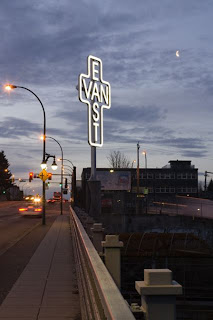
When I look at Jeff Wall's Mimic (1982), I can’t help but be embarrassed. Here we have a sophisticated Asian gentlemen minding his own business, when this white guy comes along and simultaneously gives him the finger and makes fun of his race. It seems he is walking just far enough behind the Asian gentleman so that he doesn’t actually have to confront him, and instead is able to mock him passively without risking a rebuttal. The white gentleman appears to be dragging his girlfriend along behind him in a way that suggests her subordinate role. The woman is dressed in skimpy shorts, a skimpy top, and heels. Everything about the photo makes the viewer side with the Asian man. He has the appearance of a respectable person who is a member of the business community. I think the purpose of Wall’s piece is to elicit this type of reaction, to embarrass us and compel us to side with the Asian man. The topic of racism and the Asian community is very Vancouver. As sad as it is to say, especially during the eighties, the increasing Asian population would have festered attitudes of racism. This picture exposes a racism that appears to have stemmed out of both jealousy and misdirected hatred. This photo has the effect of revealing racism as trashy and uncalled for. Although Wall’s Mimic doesn’t exactly shine Vancouver in the most positive light, it has the ability to create awareness about racism in our city.
